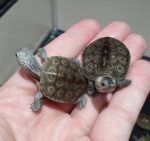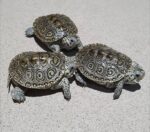Description
The Concentric Diamondback Terrapin For Sale or simply terrapin (Malaclemys terrapin) is a species of terrapin native to the brackish coastal tidal marshes of the East Coast of the United States and the Gulf of Mexico coast, as well as in Bermuda. It belongs to the monotypic genus Malaclemys. It has one of the largest ranges of all turtles in North America, stretching as far south as the Florida Keys and as far north as Cape Cod.
The name “terrapin” is derived from the Algonquian word torope. It applies to Concentric Diamondback Terrapin For Sale in both British English and American English. The name originally was used by early European settlers in North America to describe these brackish-water turtles that inhabited neither freshwater habitats nor the sea. It retains this primary meaning in American English. In British English, however, other semi-aquatic turtle species, such as the red-eared slider, might also be called terrapins.
Description of Concentric Diamondback Terrapin For Sale

The common name refers to the diamond pattern on top of its shell (carapace), but the overall pattern and coloration vary greatly. No two diamondback terrapins look alike. The shell is usually wider at the back than in the front, and from above it appears wedge-shaped. The shell coloring can vary from brown to grey, and its body color can be grey, brown, yellow, or white. All have a unique pattern of wiggly, black markings or spots on their body and head. The diamondback terrapin has large webbed feet.
The species is sexually dimorphic in that the males grow to a carapace length of approximately 13 cm (5 in), while the females grow to an average carapace length of around 19 cm (7+1⁄2 in), though they are capable of growing larger. The largest female on record was just over 23 cm (9 in) in carapace length. Specimens from regions that are consistently warmer in temperature tend to be larger than those from cooler, more northern areas. Male diamondback terrapins weigh 300 g (11 oz) on average, while females weigh around 500 g (18 oz). The largest females can weigh up to 1 kg (35 oz).
Diamondback terrapins can live up to 40 years in captivity, but scientists estimate they typically live for about 25 years in the wild.
-
The diamond pattern of the turtle’s back
-
A tub full of diamondback terrapins of various colours
Adaptations of Concentric Diamondback Terrapin For Sale to their environment
Concentric Diamondback Terrapin For Sale look much like their freshwater relatives, but are well adapted to the near shore marine environment. They have several adaptations that allow them to survive in varying salinities. They can live in full strength salt water for extended periods, and their skin is largely impermeable to salt. Terrapins have lachrymal salt glands, not present in their relatives, which are used primarily when the turtle is dehydrated.
They can distinguish between drinking water of different salinities. Terrapins also exhibit unusual and sophisticated behavior to obtain fresh water, including drinking the freshwater surface layer that can accumulate on top of salt water during rainfall and raising their heads into the air with mouths open to catch falling rain drops.
Concentric Diamondback Terrapin For Sale are strong swimmers. They have strongly webbed hind feet, but not flippers like sea turtles do. Like their relatives (Graptemys), they have strong jaws for crushing shells of prey, such as clams and snails. This is especially true of females, who have larger and more muscular jaws than males.
Subspecies Diamondback Terrapin For Sale
Seven subspecies are recognized, including the nominate race.
- M. t. centrata (Latreille, 1801) – Carolina diamondback terrapin (Georgia, Florida, North Carolina, South Carolina)
- M. t. littoralis (Hay, 1904) – Texas diamondback terrapin (Texas)
- M. t. macrospilota (Hay, 1904) – ornate diamondback terrapin (Florida)
- M. t. pileata (Wied, 1865) – Mississippi diamondback terrapin (Alabama, Florida, Louisiana, Mississippi, Texas)
- M. t. rhizophorarum Fowler, 1906 – mangrove diamondback terrapin (Florida)
- M. t. tequesta Schwartz, 1955 – East Florida diamondback terrapin (Florida)
- M. t. terrapin (Schoepff, 1793) – northern diamondback terrapin (Connecticut, Delaware, Maryland, Massachusetts, New Jersey, New York, North Carolina, Rhode Island, Virginia)
The isolated Bermudan population, which arrived in Bermuda on its own rather than being introduced by humans, has not yet been officially assigned to a subspecies but, based on mtDNA, it is closely related to the population from the Carolinas.






















Reviews
There are no reviews yet.